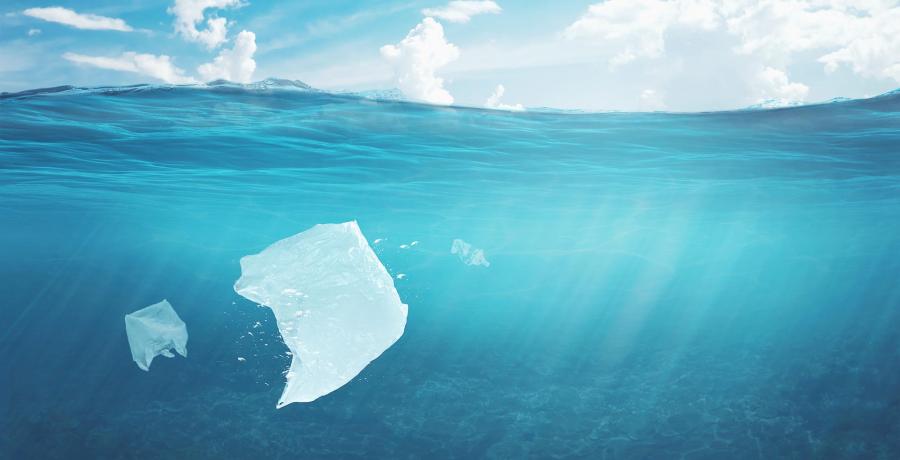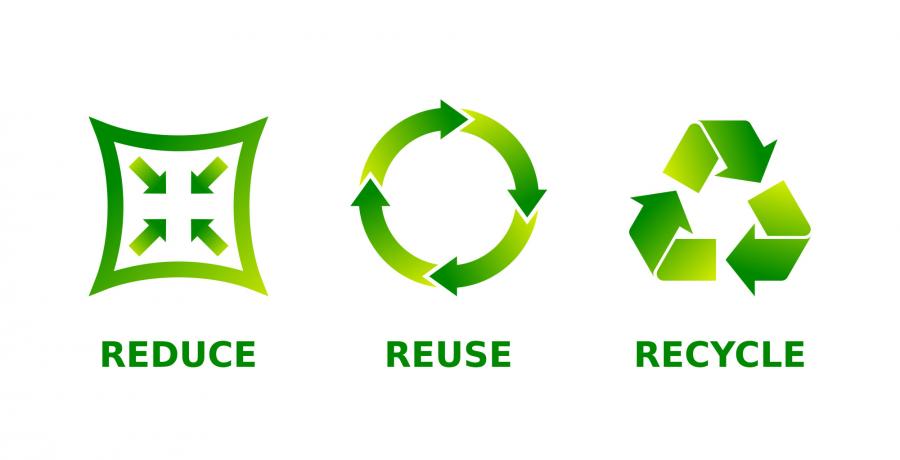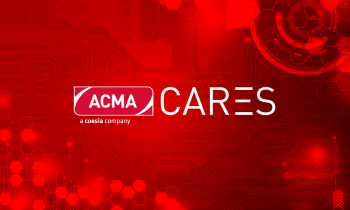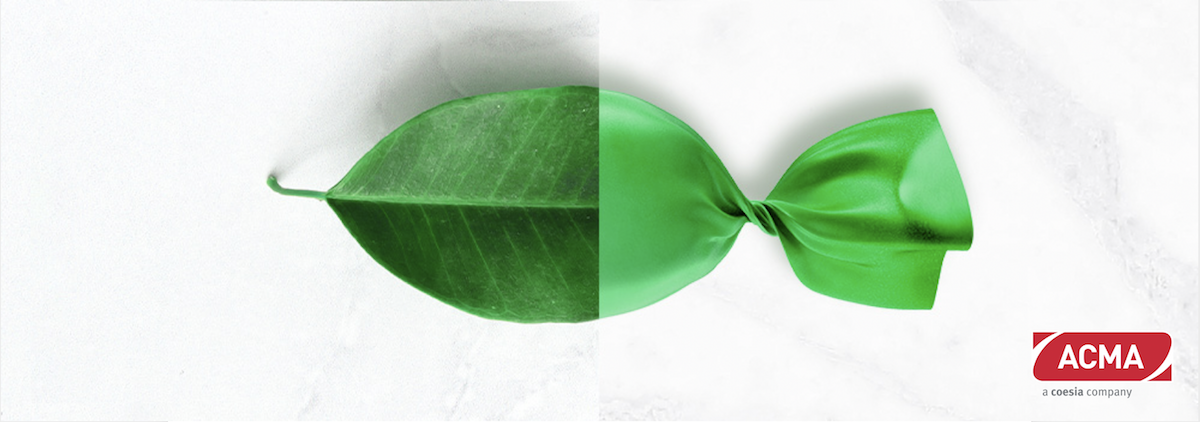Sustainability driving the future of confectionery packaging
Contents of the article
1. THE IMPORTANCE OF GLOBAL ENVIRONMENTAL SUSTAINABILITY
2. ENVIRONMENTAL PROTECTION LEGISLATION
3. THE ALTERNATIVES TO PLASTIC PACKAGING
4. ACMA’S COMMITMENT TO SUSTAINABLE CONFECTIONERY WRAPPING SOLUTIONS
The importance of global environmental sustainability
"The future is now: science for achieving sustainable development" is the title of the latest report for the United Nations 2030 Agenda. Involvement is global, sustainable development is no longer an option, but a priority for improving living conditions throughout the world.
Also from a business point of view, one should not overlook the fact that sustainability is increasingly becoming a requirement for strengthening a company’s market presence.
We are therefore seeing the gradual incorporation of environmentally friendly practices into business strategies. This means promoting the fair and efficient utilization of resources, respect for the environment and ensuring better living standards for employees and suppliers in the context of sound and rewarding company management and respect of customers. Sustainability therefore involves economic, social and environmental factors.
Consumer awareness is also increasing. Consumers acknowledge that sustainability - and in particular, the convergence between personal well-being and the environment - is a factor that can influence their purchases, even if it implies a higher cost.
A worldwide study carried out by Ipsos[1] has shown that consumers increasingly consider themselves as being more directly responsible for the environment that surrounds them.
Almost 60% of consumers worldwide also believe that their physical well-being is strongly influenced by environmental issues.
Environmental protection legislation
For quite some time, not only governments but also international organizations have been taking steps to ensure that measures are put into place to safeguard the environment.
One of the most significant initiatives is the direct commitment of the UN through the 17 Sustainable Development Goals (SDG) agreement. The general objectives are all closely linked, even if each of them aim to reach specific targets. The objectives include a total of 169 targets, with the purpose of addressing and solving a wide range of issues concerning sustainable economic and social development.
In particular, in purely environmental terms, goal 12 "Ensure sustainable consumption and production patterns" aims at pursuing tangible results, providing specific indicators and targets for achieving virtuous production models and responsible consumption, which both mirror and are interdependent of one another.
This is a green approach, which focuses on these issues, is not only able to promote businesses that are pioneers in the field of sustainability, but it also allows a benchmark to be set for less responsible companies that will have to include environment factors in their product life cycle objectives if they do not wish to lose an increasing amount of their market share.
More specifically, the worldwide proliferation of plastic, as a result of a continuous increase in production in all sectors of industry, together with the problems associated with its disposal, has prompted the companies themselves to focus specifically on these issues.
It is therefore interesting to analyse how the issue of plastic is dealt with in some areas of the world, which have the highest industrial output, in relation to the need to reduce the amount of plastic. Regulations have been put into place aimed at businesses that produce or market plastic materials: polyethylene terephthalate (PET) and high-density polyethylene (HDPE).
PET is commonly used for making plastic bottles for water or soft drinks, while HDPE is generally used for making milk jugs, shampoo bottles, house cleaning detergent bottles and other types of disposable containers.

Europe
In July 2019, the SUP (Single Use Plastic) Directive came into force in Europe with the aim of reducing the impact of certain plastic products on the environment and promote the transition to a circular economy that encourages the use of sustainable reusable packaging products and reuse systems, with the primary purpose of reducing the quantity of waste generated.
One of the objectives of the Directive is to prevent marine litter. In particular, starting from 2021, the regulation prohibits the use of some disposable plastic products for which more sustainable alternatives are already available or that need to be developed. In order to make the adaptation to the requirements more gradual, the Directive also introduces measures that will come into force at various times with respect to the transposition of the directive into national law.
Depending on the type of product, some additional targets must be met between January 2023 and December 31 2024.
Firstly, by 2025 EU member states must collect at least 77% of waste from goods placed on the consumer market, and 90% by 2029. There are also reduction targets for disposable plastic products that are still not easily replaceable, such as cups and containers for immediate food consumption such as fast and takeaway foods (and any caps or lids). In this case, the reduction percentages are established by the individual countries, as well as the measures adopted to achieve them, including the possibility of restricting their use and encouraging reusable alternatives, with or without financial incentives.
From 2025, there will also be specific regulations for manufacturers, when changes to the production process for numerous types of very common products have to be made. PET bottles, for example will have to incorporate at least 25% of recycled material; this percentage will increase to 30% in 2030.
A specific case is that of caps and lids for plastic beverage packaging: within five years of the Directive coming into force, the caps must be inseparable from the container. Within two years of the SUP Directive coming into force, there will be mandatory labelling for products such as cigarette filters, plastic cups, sanitary towels and wet wipes in order to increase consumer awareness about the negative impact on the environment of they are not disposed of correctly, in addition to precise instructions regarding their proper disposal.
Other environmental information and awareness campaigns are also planned for consumers related to the use of individual goods.
USA
Even if the United States has no comprehensive federal legislation regarding the packaging industry, the Federal Government does regulate packaging for a range of consumer goods (mainly food, pharmaceuticals and cosmetics) in order to safeguard consumers and the environment.
Currently a number of programs have been introduced by individual states to reduce the use of and correctly dispose of certain types of packaging materials, in particular plastic, and to impose minimum recycling targets.
California is undoubtedly the state that is the most proactive in the fight against reducing plastic. The California Legislature in Sacramento has recently introduced legislation to phase out disposable plastic food containers and other non-recyclable or non-compostable packaging. Supporters of the bill declared that this initiative will significantly contribute to reducing pollution due to plastic on beaches and in the oceans, which is a problem particularly felt on the West coast of the United States. In 2018, California was the first state to have restricted the use of plastic drinking straws in restaurants.
The legislation aims at progressively eliminating single-use plastics by 2030. It is expected that these regulations will also prompt other US states to adopt similar measures, as happened in 2014 when the use of disposable plastic bags was banned in California and which was then adopted by four other states immediately afterwards.
Japan
Along the same lines of European countries, the Japanese Government has issued a series of guidelines to discourage the use of disposable plastic products including drinking straws, cutlery and plastic bottles. The objective is to ban plastic from public offices and coffee shops throughout the country. In shops, on the other hand, economic incentives are used to encourage customers to choose bags made of natural materials.
In view of the G20 Osaka summit, which is scheduled for June 2020, Japan is increasing its efforts to combat environmental pollution. The measures aim to reduce 25% of the plastic in circulation by 2030.
The alternatives to plastic packaging
Most of the packaging, for the various types of goods sold, consists of disposable plastic and there are still a large number of businesses that have not yet given sufficient priority to the issue of sustainability.
In the near future, disposing of packaging is likely to become progressively more challenging because, according to estimates, the world population will reach 9 billion by 2050.
The evolutionary trends in packaging follow the principles of a circular economy, characterized by three related activities: reduce, reuse, recycle.

The application of these principles should obviously not affect the performance of the packaging. In fact, good packaging implies the need to protect the product taking into account its destination, distribution within the supply chain, marketing requirements and at the same time making the lowest possible environmental impact.
Applying the principles of sustainability means a reduction in the amount of raw materials used (also by utilizing recycled materials such as rPET in the case of beverage packaging ed), energy, water and CO2 emissions, also with a view to reducing the overall cost of the supply cycle.
The main trends in packaging solutions, developed by companies that are more involved to environmental sustainability, focus on packaging that is designed to be recycled (intended to be used more than once, for example in the case of e-Commerce packaging, which is designed for be reused in the event of return shipping). These solutions mainly involve the overall reduction in the weight of the packaging (in order to reduce transport as well as production costs), the shift towards more easily disposable mono-materials, the increase in the percentage of the recycled component and the replacement of plastic with paper and cardboard or with naturally derived products (so-called bioplastics). There are numerous and in some cases very unusual examples of these.
On the subject of innovative beverage bottles, for example, researchers[2] at the London-based start-up Skipping Rock Lab have come up with an environmentally sustainable solution called Ooho. This is an edible and tasteless packaging material, designed to contain mineral water in special bubbles that can decompose in 4-6 weeks and therefore has a zero impact on the environment.
To drink the liquid, you simply make a small hole in the transparent membrane and squeeze the contents into your mouth.
From the institutional point of view, the European Community, through the Leguval [3] project (Valorisation of legumes co-products and by-products for package application and energy production from biomass), is financing the development and production of renewable materials derived from by-products of legumes, especially peas, beans and lentils.
To date, the project has already produced some preliminary results by making films from which more complex products have been made that have some possible future uses for packaging.
On the other side of the Atlantic, a team of researchers in Wisconsin [4] have undertaken a research project, published in the "Science” magazine, to eliminate oil from PET raw materials by replacing it with a mixture of sugar and corncobs. The production costs are only slightly higher than those for traditional raw materials (+ 3%) which leaves hope for its future application.
These examples, by and large, show that it is possible to do without traditional plastic. From the point of view of manufacturers, the most important aspect is that of producing suitable packaging solutions and that can be used on packaging machines available on the market.
ACMA’s commitment to sustainable confectionery wrapping solutions
In the confectionery wrapping sector, the revolution is already underway. Many companies that currently use laminated materials composed mainly of aluminium and plastic will have to replace it progressively with materials that are easier to recycle. This is why the main brands that operate in international markets are adopting alternative, more sustainable, cardboard, aluminium and bioplastic based confectionery-wrapping solutions.
ACMA is ready to assist its customers in this evolutionary process and to accept the challenge to make the world greener. Investment in technology and its extensive experience in the management of products and materials means that ACMA has not only been able to design new machines and solutions capable of handling sustainable materials, but also to modify and update existing equipment so that they can use the new environmentally friendly materials.
ACMA's experience is also strengthened by its collaboration with Coesia’s packaging innovation center: a centre of excellence where the latest market trends and the most innovative solutions in terms of design and packaging materials are researched.
This ensures that we can provide our customers with the opportunity to offer completely eco-friendly products.
Do you wish to learn about confectionery wrapping solutions that can align your packaging with environmental sustainability objectives?
CONTACT OUR EXPERTS



